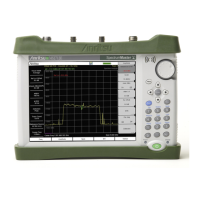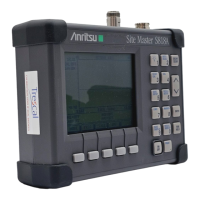Spectrum Analyzer 2-6 Sweep Limitations
Spectrum Analyzer MG PN: 10580-00349 Rev. H 2-9
2-6 Sweep Limitations
With some spectrum analyzers, the user has control over sweep time (the elapsed time of each
sweep, sometimes called scan time). An analyzer cannot be swept arbitrarily fast while
maintaining its specified accuracy, but will have a sweep rate limitation depending upon the
resolution bandwidth, video bandwidth, and frequency range selected. The sweep rate is not
usually chosen by the user but is determined by the frequency range swept divided by the
sweep time. The limitation on sweep rate comes from the settling or response time of the
resolution and video bandwidth filters. If an analyzer is swept too quickly, the filters do not
have time to respond, and the measurement is inaccurate. Under such conditions, the
analyzer display tends to have a “smeared” look to it, with the spectral lines being wider than
normal and shifted to the right and at a lower amplitude than is correct.
Anritsu products are designed to relieve the user from having to calculate the sweep speed or
experiment to discover a sweep speed that yields accurate results. When changing the RBW
and VBW, the sweep speed automatically changes to the fastest sweep speed that will yield
accurate results. The sweep speed will be faster for a wide RBW or VBW and slower for a
narrow RBW or VBW. The sweep speed can also be changed manually, by pressing the Sweep
key and selecting the Sweep Time submenu key. Enter a sweep time from 10 μs to
600 seconds. If the minimum sweep time entered by the user is less than the value needed to
assure accurate results, the value that delivers accurate results will be used. Regardless of
the minimum sweep time setting, the instrument will never sweep faster than the RBW and
VBW settings will allow. The instrument is designed to ensure that no uncalibrated
measurement conditions will occur.
2-7 Attenuator Functions
The Spectrum Analyzer includes a step attenuator at the RF input. This attenuator is used to
reduce large signals to levels that make best use of the analyzer’s dynamic range. Normally,
the input attenuation automatically adjusts as a function of Reference Level. In the
Amplitude menu, the Attn Lvl key allows manual adjustment of the input attenuation, using
the numeric keypad, the Up/Down arrow keys, or the rotary knob. In Auto Atten mode, as the
reference level is increased, the attenuation is increased.
Note
The following actions, listed in decreasing order of effectiveness, can facilitate the
detection of low-level CW signals:
1. Decrease the reference level and attenuation. Refer to “Amplitude Menu”
on page 2-55.
2. Turn on the Preamp.
3. Reduce RBW. Refer to “BW (Bandwidth) Menu” on page 2-59.
4. Decrease VBW (RBW/VBW = 10 is often optimal for this purpose).
5. Use trace averaging if VBW is already set to 1 Hz.
ООО "Техэнком" Контрольно-измерительные приборы и оборудование www.tehencom.com
